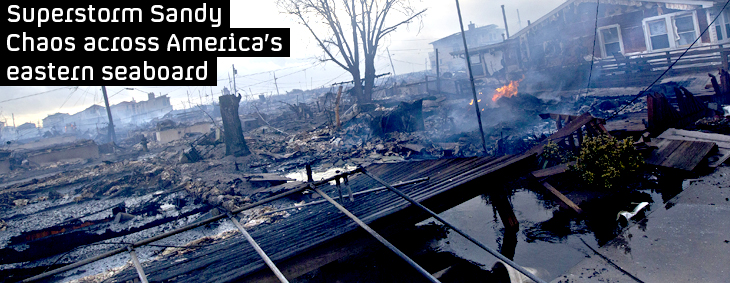Superstorm Sandy: counting the economic cost
Transport systems wrecked. Homes badly damaged. Businesses shut and power supplies cut for days on end. The economic cost of the superstorm could reach $20bn – or more.

It could be days before the full cost of the disaster is clear. But just think about the sheer scale of the disruption, and it is not hard to see why some analysts are predicting the economic damage of superstorm Sandy could top $20bn.
In New York alone, almost 2 million people have been left without power, while flood waters have swept through key tunnels into Manhattan and parts of the subway system, which could take days to repair.
Transport chief Ray Lhota described “epic flooding”, the most destructive in the subway system’s history. “In 108 years, our employees have never faced a challenge like the one that confronts us now,” he said, promising to do everything he could to bring New York back to normal.
Flood waters put electricity substations out of action too, forcing Con.Ed to switch off power to parts of downtown Manhattan, as the storm surge sent saltwater pouring into its underground network.
In 108 years, our employees have never faced a challenge like the one that confronts us now. Ray Lhota, MTA chief
Seven nuclear power stations have been shut or slowed down, while the country’s oldest nuclear facility, at New Jersey’s Oyster Creek, was put on a rare alert status as flood waters rose high enough to put a cooling system at risk.
The alert signifies a “potential degredation in the level of safety”, a serious but not catastrophic event and, according to FEMA boss Craig Fugate, one that doesn’t mean there is any imminent threat.
Trading halted
On the money markets, with New York’s financial district completely out of action, the stock exchange has remained closed for an unprecedented second day: on the eve of the crucial end-of-month trading day.
And there has been a huge loss in economic activity as a whole. In Washington DC, all federal government offices have been shut for two days, along with public transport, banks and huge numbers of shops and businesses.
Transport is in a complete mess: thousands of flights have been cancelled again, major roads have been closed or heavily restricted, and the chaos is likely to continue for the rest of the week, with airports in the New York area out of action for days.
Once you start getting water into your infrastructure, the numbers start to go crazy. Charles Watson, Kinetic Analysis
It is a similar picture across the affected states. One analyst, Oliver Chen from Citigroup, estimated that closures and travel problems could push shopping activity down by 40 per cent over the next week.
And all of this is before you take into account the cost of the damage to property and infrastructure. The catastrophic risk analyst Equecat has estimated that of the $10 to $20bn in total economic damages, around half could be down to insured losses.
Counting the cost, though, is not as simple as merely adding up insurance payouts and other losses – not when so much has been damaged and when the impact could last so long. Charles Watson, from the hazard research group Kinetic Analysis, told Business Week: “Once you start getting water into your infrastructre, the numbers start to go crazy.”
There is talk of the damage wiping as much as 0.2 per cent off the nation’s gross domestic product, further dented by the millions of dollars in lost output, productivity and consumer spending.
Repairing the damage
Some businesses have been especially hard hit, like restaurants, entertainment venues and hotels. In the flooded Atlantic City, closing the town’s casinos is said to cost as much as $50m a day.
But there’s a positive side to the rebuilding: all of it will create work and generate income, which some experts predict could even boost GDP in the future. Going out to the shops might be impossible, but people have been buying storm supplies and DIY equipment.
So while retail sales figures, industrial production and economic activity as a whole may take an immediate dive, the effect might not last long. A hefty impact might fall on states, which bear the brunt of repairing roads, bridges and public transport networks.
At least federal government relief can help fill the gap: that, and insurance companies, which by all accounts have deep enough coffers to cope with a rush of claims.
But for the communities devastated by the super storm, the financial cost is just part of it. Lives have been lost, homes destroyed, communities battered. Costly it may be, but the challenge of getting back to normal is about far more than dollars and cents.
Felicity Spector writes about US politics for Channel 4 News





